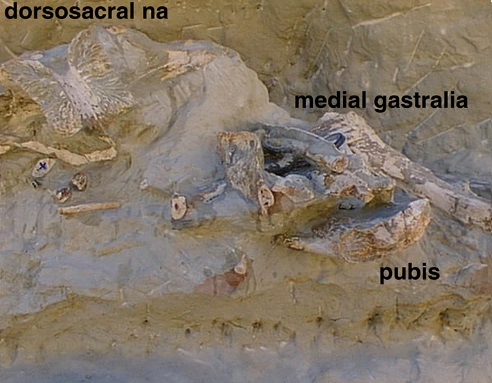
Body reconstruction of Murusraptor barrosaensis (From Coria et al., 2016)
Patagonia has yielded the most comprehensive fossil record of Cretaceous theropods from Gondwana, including Megaraptora, a clade of medium-sized and highly pneumatized theropods represented by Megaraptor, Orkoraptor and Aerosteon, and characterized by the formidable development of their manual claws on digits I and II and the transversely compressed and ventrally sharp ungual of the first manual digit (Novas et al, 2013). The enigmatic nature of this group has been a matter of discussion since the description of the first megaraptoran, Megaraptor namunhaiquii. For years, Megaraptor has been alternatively interpreted as belonging to different theropod lineages: as basal coelurosaurians (Novas,1998), basal tetanurans (Calvo et al.,2004; Smith et al., 2008), and allosauroids closely related with carcharodontosaurids (Smith et al., 2007; Benson et al., 2010; Carrano et al., 2012). The main reason for so many different interpretations is the incomplete nature of most available megaraptorid skeletons and the little information about their cranial anatomy.
Murusraptor barrosaensis, from the Upper Cretaceous of Neuquén Province, Argentina, belongs to a Patagonian radiation of megaraptorids together with Aerosteon, Megaraptor and Orkoraptor. Murusraptor, meaning “Wall Raptor”, was discovered in a canyon wall in 2001 during an expedition to Sierra Barrosa in northwestern Patagonia. The holotype specimen includes much of the skull, axial skeleton, pelvis and tibia. The braincase is intact and most of the sutures are still visible, indicating that this was not a fully mature animal.

Different appendicular elements of Murusraptor in their original burial positions (From Coria et al., 2016)
Murusraptor barrosaensis is unique in having anterodorsal process of lacrimal longer than height of preorbital process; sacral ribs hollow and tubelike; short ischia distally flattened and slightly expanded dorsoventrally.
Murusraptor shares with all Megaraptoridae two unambiguous synapomorphies: teeth with no enamel wrinkles (interpreted as a reversion to primitive condition in Theropoda); and anterior caudal vertebrae with neural arch bearing prominent centrodiapophysial laminae that define a deep infradiapophysial fossa. Murusraptor also exhibits some characters that are interpreted as convergencies of this taxon with non-tyrannosauroid theropods, including lacrimal with a small pneumatic recess; and a highly pneumatic braincase (Coria et al., 2016)
References:
Rodolfo A. Coria, Philip J. Currie. A New Megaraptoran Dinosaur (Dinosauria, Theropoda, Megaraptoridae) from the Late Cretaceous of Patagonia. PLOS ONE, 2016; 11 (7): e0157973 DOI: 10.1371/journal.pone.0157973
Porfiri, J. D., Novas, F. E., Calvo, J. O., Agnolín, F. L., Ezcurra, M. D. & Cerda, I. A. 2014. Juvenile specimen of Megaraptor (Dinosauria, Theropoda) sheds light about tyrannosauroid radiation. Cretaceous Research 51: 35-55.